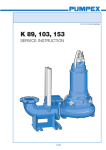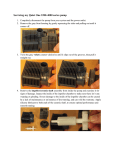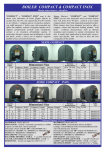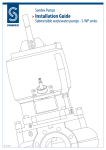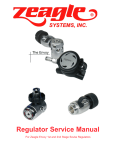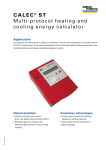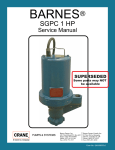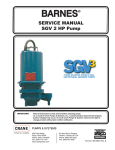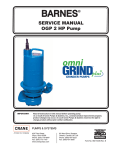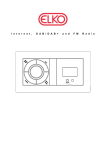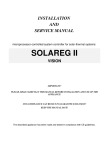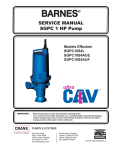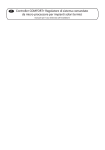Download K 80/83/87/100/150 service instructions
Transcript
K 80/83/87/100/150.58.0410.Eng/Digital K 80, 83, 87, 100, 150 SERVICE INSTRUCTION 1 (16) SERVICE INSTRUCTION K 80, 83, 87, 100, 150 K 80/83/87/100/150.58.0410.Eng/Digital This service manual covers the pumps K80, K83, K87, K 100 and K150 in following designs: Type F Wet Pit Installation Installed on a guide rail system with a quick-release base elbow, the base elbow is bolted to the floor of the sump. The volute is equipped with an adapter to be connected to the discharge elbow. Two twin guide rails are mounted to the discharge elbow to steer the pump into right position when hoisted up and down. Type T, Dry Pit Installation Installed in a normally dry well, but still fully submersible. The pump is supported by an adjustable fabricated steel stand, mounted at the factory. The height of the stand is sufficient for the standard suction elbow to be used on a flat floor. The pump volute is drilled or threaded on the connection-flange and equipped with studs on the suction flange. The motors are equipped with a maintenance-free internal, closed loop cooling system which dissipates the heat to the liquid that is being pumped. Type P, Wet Pit Portable or fixed installation A version of pump which is suitable for temporary or permanent installations. The pump is equipped with a fabricated steel stand and either a threaded (BSP, NPT) or plain hose connection. The motor can if required, be equipped with a maintenancefree internal, closed loop cooling system which dissipates the heat to the liquid that is being pumped. When installed without a cooling jacket, the minimum water level in the wet well for continuous operation should not be below the top edge of the pump house. Intermittent operation down to a water level above half the height of the stator is acceptable, see picture. For continuous operation at water levels below the top edge of the pump house, an internal cooling jacket is recommended. The pumps are divided into three categories: Standard, Ex and Fm. The difference between the three is the wear plate. In the standard version there is a hole drilled for the moisture switch. On the Ex there is no hole and the Fm version has a threaded hole. The Volute The volutes are equipped with adjustable wear rings as standard. The volute on the K83 and K87 is only available in the Vortex impeller design and has got no wear rings. K 80 20 m No 99999999 U 400 V I 5,4 A Y 1 2 3 4 P.2 2.0 kW 5 n 1385 rpm 6 3 Ph Class F 50 Hz 7 IP68 8 98 kg 9 Box 5207 S - 12116 JOHANNESHOV SWEDEN 2 (16) 1 2 3 4 5 6 7 8 9 Type of pump Serial number Working voltage Rated current Rated output Engine speed Frequency Winding class Weight SERVICE INSTRUCTION K 80, 83, 87, 100, 150 K 80/83/87/100/150.58.0410.Eng/Digital Warning ! The pump and its electrical cables must be disconnected from any power source by a qualified electrician before any inspection or service is performed! Removal from the wet well Hoist the pump from the sump and rinse clean. Disassembling the volute The driving unit is connected to the volute with two nuts. Loosen them and lift off the driving unit. Cooling Kylvatten water in in Changing the oil Remove the two oilplugs. Slant the pump and discard used oil in accordance with local regulations. Fasten one of the plugs. Fill with new oil and fasten the second plug. Oil Olja Type of oil: white oil (Enerpar M002 or similar). Qty. without the cooling mantle (l): Qty. with the cooling mantle (l): K 80/83 K 87/100/150 1,2 0,32 2,2 0,45 Changing the cooling liquid Loosen the cooling liquid plugs so that the old water can pour out. Then replug the lower plug. Hold the pump, facing the plug and slant it toward you ca 30 degrees. Slowly fill the new water, use a funnel or similar because of the air bubbles that will obstruct the filling. Cooling liquid, quantity (l): K 80/83 K 87/100/150 1.75 / 4* 3.2 / 6,2* (30% Propylene glycol DOWCAL ® 20) Disassembling the impeller The impeller is bolted to the shaft with a washer and a bolt. Securing the impeller, remove the impeller bolt with a wrench. Disassembling the seal cartridge Disassemble volute and impeller as above, and empty the motor of cooling liquid and oil. Lay the rotating element on its side. Remove the four screws that holds the seal cartridge. The cartridge can be removed from the oil chamber by inserting the set screws into the "jacking holes" in the cartridge, which will force the cartridge from the housing. 3 (16) Oil Olja Cooling ut Kylvatten water out * = valid from serial number: K80: 80003480, K83: 83100880, K87: 87000350, K100: 10002000 and K150: 15000074 SERVICE INSTRUCTION K 80, 83, 87, 100, 150 K 80/83/87/100/150.58.0410.Eng/Digital Changing the cable seal If water has gotten through the cable seals to the terminal board area, the connection seals has to be replaced. The cable gland seal should be replaced after every disassembly of the cable gland. Measure the cable diameter with a slide gauge and compare with the holes in the cable gland seal and the spacers so that the dimensions are alike. Pull the seal onto the cable with one spacer underneath. Pull the cable as far through the cover so that a new part of the cable gets jammed when tightening the cable gland. Tighten the four scews of the cable gland. Disassembling the cooling jacket Remove the four screws that holds the outer casing and the handle. Lift them off. Changing the stator unit If the motor protection trips repeatedly, the stator has to be overhauled. Disconnect the pump from the electric box. Check the isolation resistance of the motor at the loose end of the cable. Use a megger. If using a 500 V megger the isolation resistance shall exceed 1 megaohm. This applies to phase to phase readings as well as between each phase to ground. If any problems occurs, disconnect the cable from the stator and measure directly at the stator. If the isolation resistance is less than 1 megaohm the stator should be dried in an oven. Also check the circuit with the built-in thermal overload switches using a buzzer or a bell. If the circuit is open, probably one of the overload switches is defective and should be located by testing each one. The defective switch is bypassed according to the connection scheme on page 8. If the stator still can´t be used, it has to be replaced. Disconnect the stator from the outgoing cables and disassemble it. Order a exchange stator unit from the nearest Pumpex Service Center. 4 (16) SERVICE INSTRUCTION K 80, 83, 87, 100, 150 K 80/83/87/100/150.58.0410.Eng/Digital Disassembling the stator Remount the handle as it was before the disassembly of the cooling jacket. Remove the four screws that holds the stator casing. Gently, with a hoist, lift the stator casing from the shaft. Remember that the rotor and the upper bearing can follow if the impeller is disasssembled when lifting. If this happens, the rotor can easily be pulled out by only using the hands. Disconnect from withunder the cables from the stator. Put the stator unit on a distance tube. Take the pressure tool from withunder and put it on the stator. Pull the stator out of the casing. Disassembling the rotor and bearings The rotor is mounted in the oil chamber with an upper and lower bearing. The lower bearing is held in place by the seal cartridge and the rotor by the impeller. Carefully lift out the rotor with the upper bearing from the oil housing. Bearings that has been in contact with water or that are damaged should always be replaced. Place the withdrawing tool on the upper bearing and see to that it pulls the inner ring. The lower bearing is in the bearing seat on the bottom side of the oil housing. To reach the lower bearing the seal cartridge has to be disassembled. Assembling Clean all O-ring grooves and all other contact surfaces carefully. Use a wire brush when necessary. Lubricate all O-rings with oil or grease to prevent the O-rings from getting stuck or damaged when remounted. Also lubricate the threads on all the screws to facilitate disassembling when serviceing next time. Mounting the bearings Check that the shaft is straight and that the key way isn´t damaged. Polish eventual scratches and burrs off. Push the upper bearing into its place. If a press isn´t available, heat the bearing to 100-120o C in a oilbath. Wipe clean the shaft contacting surfaces of the bearing and mount it. Place the bearing cover on the shaft and mount the lower bearing by using only your hands. Don´t forget to refill the bearings with grease. The lower bearing is mounted on the shaft when the shaft/rotor is mounted in the oil housing. 5 (16) SERVICE INSTRUCTION K 80, 83, 87, 100, 150 K 80/83/87/100/150.58.0410.Eng/Digital Mounting the rotor in the oil housing Push the lower bearing into the bearing seat by pushing lightly with your hand at the end of the shaft. Hold the seal cartridge still as said below. Push the shaft down from above. Lock the rotor by fastening the impeller. Mounting the seal cartridge Put down the driving unit. Lubricate the shaft and all four o-rings on the seal unit (three external on the seal housing and one internal in the seal cap). Carefully push the seal unit onto the shaft, and place it in position by aligning the screw holes. Do not use hard striking tools Tighten the seal unit by fastening the four screws. NOTE! Never run the motor without having the impeller mounted, if the seal is mounted. This can cause damage to O-rings in seal. Mounting the impeller Turn the shaft so that the key way is upward. Put the key in its groove and push the impeller onto the shaft. Lock the impeller from rotating with a pipe or similar and fasten the impeller washer and screw. Mounting the stator Push the stator in with the pressure tool. Pull the outgoing cable through the cable seal. Connect the cables to the stator and mount the cable cover. Erect the oil housing and clean all contact surfaces between oil housing and the stator unit with a wire brush. Lubricate and mount a new O-ring on the oil housing. The stator is now ready to be mounted on the oil housing. Lift the stator with a lift device and carefully lower it over the rotor. See to that the rotor does not damage the windings or the stator stick. Fasten the stator with the four screws. Mounting the cooling jacket Mount the external cooling pipes. Lower the cooling jacket over the stator casing so that the internal cooling pipe comes straight above the screw for cooling liquid change. Fasten the stator with the four screws. Note! Don´t forget to fill cooling liquid! 6 (16) SERVICE INSTRUCTION K 80, 83, 87, 100, 150 K 80/83/87/100/150.58.0410.Eng/Digital Mounting the rotating element to the volute Place the driving unit in the volute. Fasten the two nuts. Adjusting the wear ring Lay the pump down on its side and check the clearance inbetween impeller and wear ring. The clearance should be 0,7 mm maximum. The wear ring is placed on the bottom side of the volute and is fastened by three screws placed horizontally. Loosen these screws and adjust with the three vertically placed screws. When necessary strike carefully with a hammer or plastic club. When the distance is adjusted the horizontally placed screws can be tightened. Note! This applies only if using channel impeller. If using vortex impeller do not adjust the wear ring! The K83 and K87 does not have a wear ring due to the vortex design. Testing Connect the cables to the electric mains and start the pump. This should only be done by a qualified electrician. The arrow on the cover indicates the direction of rotation - clockwise, when viewed from the top of the motor. The starting reaction will be in the opposite direction. Attention! Remember to check the lifting loop and screws each time the pump is hoisted from the pit. 7 (16) SERVICE INSTRUCTION K 80, 83, 87, 100, 150 K 80/83/87/100/150.58.0410.Eng/Digital 50 Hz 3 Y/Ä Thermal switches Leakage sensor Ä Thermal switches 2 Leakage sensor Thermal switches Y Leakage sensor 1 351849 AB 351850 AB 351855 AB 60 Hz 4 L1 7 core cable = U 50/60Hz L2 L3 V W 5 230 V 60 Hz Y-PARALLEL F1 7 core AWG = T1 T2 T3 cable 60Hz (Red) (White) (Black) F0 7 core cable = U1 V1 W1 50/60Hz DI 1 2 (Orange) 6 L1 L2 L3 3 (Blue) 7 core AWG cable 60Hz = T1 T2 T3 460 V 60 Hz Y-SERIES (Red) (Black) (White) F1 F0 DI 1 3 2 (Orange) (Blue) (Black/ white) (Black/ white) L1 2 3 U1 V1 W1 U2 V2 W2 4 5 1 6 2 4 3 5 230 V 60 Hz Y-PARALLEL F1 F0 7 8 DI U1 U5 V1 V5 W1W5 1 5 1 L3 L2 2 6 3 4 U1 V1 W1 U2 V2 W2 9 6 351851 AC 1 5 U1 L2 2 6 3 4 V1 W1 F1 F0 7 W2 V2 U2 U5 V5 8 W5 351852 AB DI Size M6 M8 M10 M12 M14 M16 9 [Nm] 7 17 33 57 91 140 W5 351854 AB 8 (16) Connection scheme Leakage sensor Leakage sensor V5 Tightening factor Specification for screws included in pump L3 460 V 60 Hz Y-SERIES U5 351853 AC Leakage sensor L1 Thermal switches 7 W5 Thermal switches W5 U5 V5 Leakage sensor V5 Thermal switches U5 W2 V2 U2 Thermal switches U1 V1 W1 SERVICE INSTRUCTION K 80, 83, 87, 100, 150 K 80/83/87/100/150.58.0410.Eng/Digital 9 (16) SERVICE INSTRUCTION K 80, 83, 87, 100, 150 K 80/83/87/100/150.58.0410.Eng/Digital 10 (16) SERVICE INSTRUCTION K 80, 83, 87, 100, 150 K 80/83/87/100/150.58.0410.Eng/Digital 11 (16) SERVICE INSTRUCTION K 80, 83, 87, 100, 150 K 80/83/87/100/150.58.0410.Eng/Digital 12 (16) SERVICE INSTRUCTION K 80, 83, 87, 100, 150 K 80/83/87/100/150.58.0410.Eng/Digital 13 (16) SERVICE INSTRUCTION K 80, 83, 87, 100, 150 K 80/83/87/100/150.58.0410.Eng/Digital 14 (16) SERVICE INSTRUCTION K 80, 83, 87, 100, 150 K 80/83/87/100/150.58.0410.Eng/Digital 15 (16) SERVICE INSTRUCTION K 80, 83, 87, 100, 150 K 80/83/87/100/150.58.0410.Eng/Digital 16 (16)
















